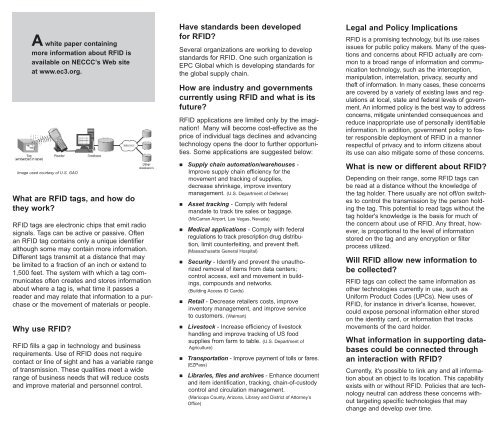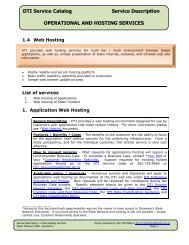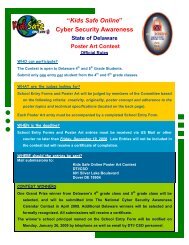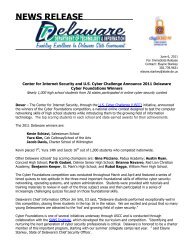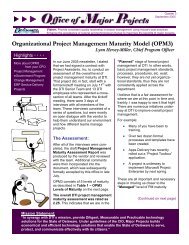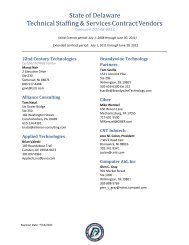RFID - Delaware's Department of Technology and Information
RFID - Delaware's Department of Technology and Information
RFID - Delaware's Department of Technology and Information
You also want an ePaper? Increase the reach of your titles
YUMPU automatically turns print PDFs into web optimized ePapers that Google loves.
A white paper containingmore information about <strong>RFID</strong> isavailable on NECCC’s Web siteat www.ec3.org.Image used courtesy <strong>of</strong> U.S. GAOWhat are <strong>RFID</strong> tags, <strong>and</strong> how dothey work?<strong>RFID</strong> tags are electronic chips that emit radiosignals. Tags can be active or passive. Oftenan <strong>RFID</strong> tag contains only a unique identifieralthough some may contain more information.Different tags transmit at a distance that maybe limited to a fraction <strong>of</strong> an inch or extend to1,500 feet. The system with which a tag communicates<strong>of</strong>ten creates <strong>and</strong> stores informationabout where a tag is, what time it passes areader <strong>and</strong> may relate that information to a purchaseor the movement <strong>of</strong> materials or people.Why use <strong>RFID</strong>?<strong>RFID</strong> fills a gap in technology <strong>and</strong> businessrequirements. Use <strong>of</strong> <strong>RFID</strong> does not requirecontact or line <strong>of</strong> sight <strong>and</strong> has a variable range<strong>of</strong> transmission. These qualities meet a widerange <strong>of</strong> business needs that will reduce costs<strong>and</strong> improve material <strong>and</strong> personnel control.Have st<strong>and</strong>ards been developedfor <strong>RFID</strong>?Several organizations are working to developst<strong>and</strong>ards for <strong>RFID</strong>. One such organization isEPC Global which is developing st<strong>and</strong>ards forthe global supply chain.How are industry <strong>and</strong> governmentscurrently using <strong>RFID</strong> <strong>and</strong> what is itsfuture?<strong>RFID</strong> applications are limited only by the imagination!Many will become cost-effective as theprice <strong>of</strong> individual tags declines <strong>and</strong> advancingtechnology opens the door to further opportunities.Some applications are suggested below:• Supply chain automation/warehouses -Improve supply chain efficiency for themovement <strong>and</strong> tracking <strong>of</strong> supplies,decrease shrinkage, improve inventorymanagement. (U.S. <strong>Department</strong> <strong>of</strong> Defense)• Asset tracking - Comply with federalm<strong>and</strong>ate to track tire sales or baggage.(McCarran Airport, Las Vegas, Nevada)• Medical applications - Comply with federalregulations to track prescription drug distribution,limit counterfeiting, <strong>and</strong> prevent theft.(Massachusetts General Hospital)• Security - Identify <strong>and</strong> prevent the unauthorizedremoval <strong>of</strong> items from data centers;control access, exit <strong>and</strong> movement in buildings,compounds <strong>and</strong> networks.(Building Access ID Cards)• Retail - Decrease retailers costs, improveinventory management, <strong>and</strong> improve serviceto customers. (Walmart)• Livestock - Increase efficiency <strong>of</strong> livestockh<strong>and</strong>ling <strong>and</strong> improve tracking <strong>of</strong> US foodsupplies from farm to table. (U.S. <strong>Department</strong> <strong>of</strong>Agriculture)• Transportation - Improve payment <strong>of</strong> tolls or fares.(EZPass)• Libraries, files <strong>and</strong> archives - Enhance document<strong>and</strong> item identification, tracking, chain-<strong>of</strong>-custodycontrol <strong>and</strong> circulation management.(Maricopa County, Arizona, Library <strong>and</strong> District <strong>of</strong> Attorney’sOffice)Legal <strong>and</strong> Policy Implications<strong>RFID</strong> is a promising technology, but its use raisesissues for public policy makers. Many <strong>of</strong> the questions<strong>and</strong> concerns about <strong>RFID</strong> actually are commonto a broad range <strong>of</strong> information <strong>and</strong> communicationtechnology, such as the interception,manipulation, interrelation, privacy, security <strong>and</strong>theft <strong>of</strong> information. In many cases, these concernsare covered by a variety <strong>of</strong> existing laws <strong>and</strong> regulationsat local, state <strong>and</strong> federal levels <strong>of</strong> government.An informed policy is the best way to addressconcerns, mitigate unintended consequences <strong>and</strong>reduce inappropriate use <strong>of</strong> personally identifiableinformation. In addition, government policy to fosterresponsible deployment <strong>of</strong> <strong>RFID</strong> in a mannerrespectful <strong>of</strong> privacy <strong>and</strong> to inform citizens aboutits use can also mitigate some <strong>of</strong> these concerns.What is new or different about <strong>RFID</strong>?Depending on their range, some <strong>RFID</strong> tags canbe read at a distance without the knowledge <strong>of</strong>the tag holder. There usually are not <strong>of</strong>f/on switchesto control the transmission by the person holdingthe tag. This potential to read tags without thetag holder's knowledge is the basis for much <strong>of</strong>the concern about use <strong>of</strong> <strong>RFID</strong>. Any threat, however,is proportional to the level <strong>of</strong> informationstored on the tag <strong>and</strong> any encryption or filterprocess utilized.Will <strong>RFID</strong> allow new information tobe collected?<strong>RFID</strong> tags can collect the same information asother technologies currently in use, such asUniform Product Codes (UPCs). New uses <strong>of</strong><strong>RFID</strong>, for instance in driver's license, however,could expose personal information either storedon the identity card, or information that tracksmovements <strong>of</strong> the card holder.What information in supporting databasescould be connected throughan interaction with <strong>RFID</strong>?Currently, it's possible to link any <strong>and</strong> all informationabout an object to its location. This capabilityexists with or without <strong>RFID</strong>. Policies that are technologyneutral can address these concerns withouttargeting specific technologies that maychange <strong>and</strong> develop over time.


